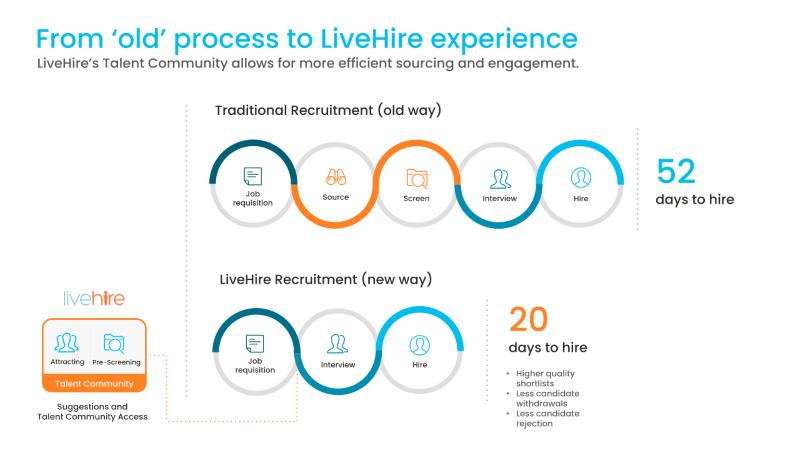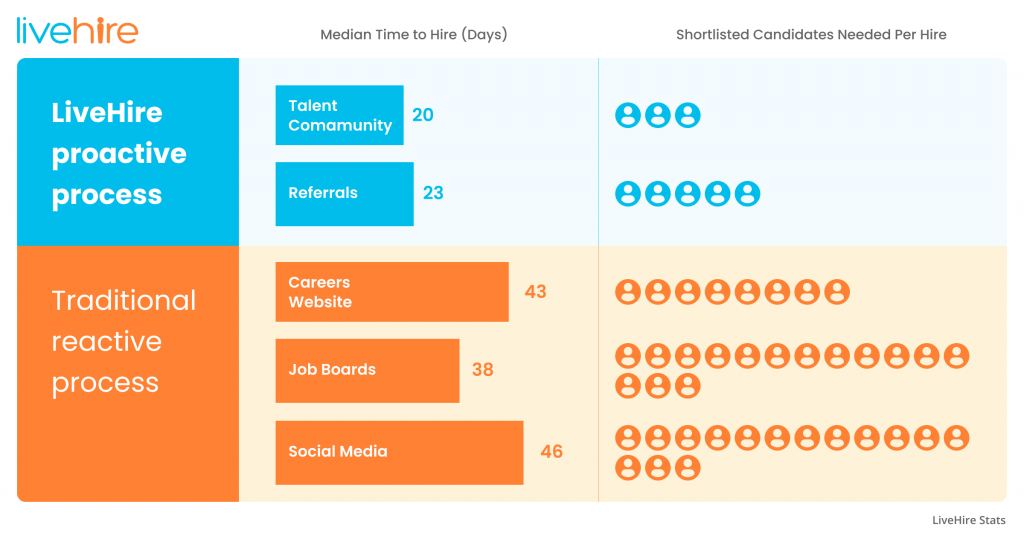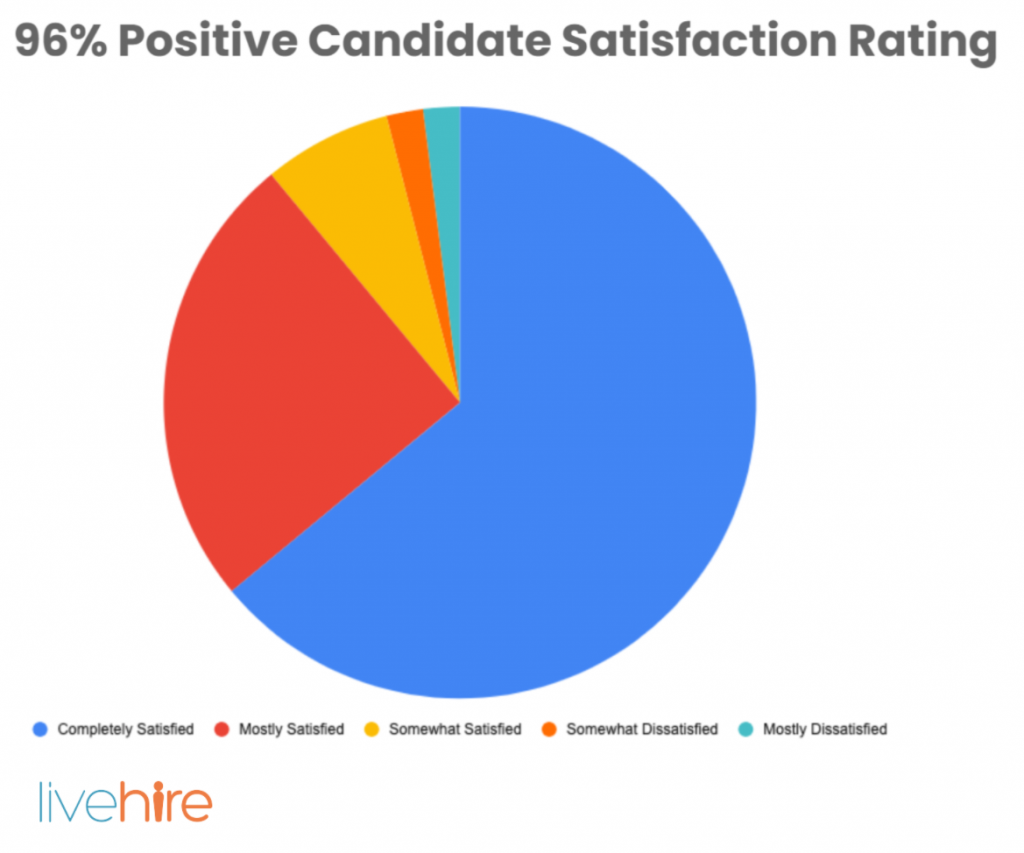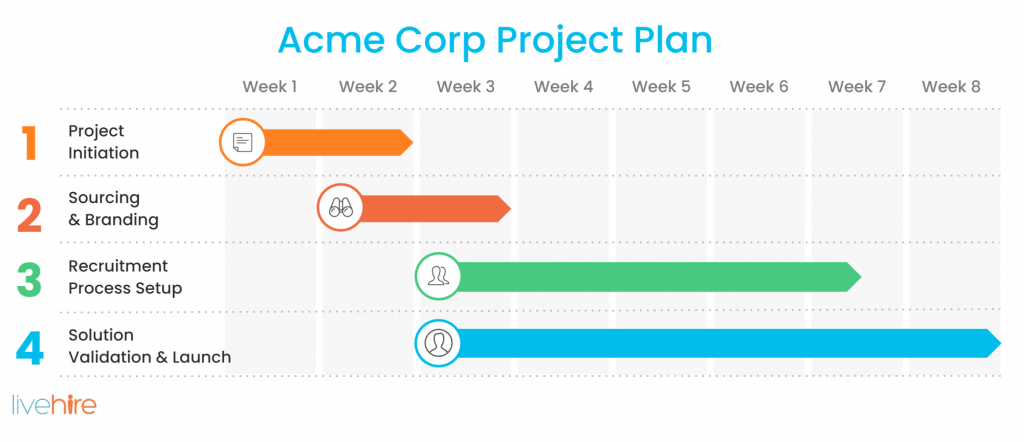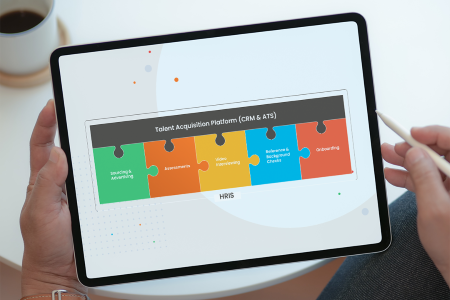
Recruiting used to rely on traditional methods to hire talent, such as advertising on job boards or partnering with recruitment agencies. But recent market and technology shifts, along with the impact of COVID-19, have compromised the effectiveness of these approaches and accelerated changes to the way we source, hire and inspire the best talent.
Adapting your approach to talent acquisition and engagement often requires an upgrade to your HR tech stack, but shopping for new technology solutions can be overwhelming – particularly in the HR space, where there may be hundreds of options to consider. Given how quickly the technology landscape is changing, many of the recruitment solutions sold by vendors today are outdated. They simply don’t deliver the process or cost efficiencies that modern technologies are able to do with ease. Having the best HR strategy in the world won’t work if the right technology does not underpin it.
So what are the key questions you should ask HR tech vendors to determine which solution is right for you? Here’s a list to help you get started:
Questions to ask HR Tech Vendors for your Recruitment Solutions
- How will this recruitment solution help us to reduce our hiring costs?
- How will this recruitment solution help us achieve our performance targets (e.g. faster time-to-hire, better quality of hire)?
- How will this recruitment solution help us reduce candidate rejection and improve our candidate conversion rate?
- How can you help us deliver a better experience for candidates, recruiters and hiring managers?
- What technologies does your recruitment solution integrate with and how can you help us think through our HR tech stack?
- Can you provide any data to demonstrate the positive impact of your technology on improved hiring diversity?
- Will Hiring Managers have access? Are there different access levels we can set up?
- Are there additional costs for modules or add-ons?
- How does the implementation process work? Can you share an example project plan?
- What resources will be required from our team to complete implementation?
- What’s an estimated implementation timeframe?
- Will we have a dedicated Client Success Manager? Are they based locally? What is their background/experience?
- How regularly is your product updated with new features and enhancements? Do all customers benefit from these updates?
- Can you share your privacy policy, security statement and service level agreements?
- Where is the data stored for your solution?
How will this recruitment solution help us to reduce our hiring costs?
“If it cannot be measured, it cannot be managed” — Peter Drucker. Measurement equals success in HR solutions, and the latest HR technologies enable you to manage current metrics with ease and give you new, important metrics to track. If your technology does not have dashboards and metrics, it will be impossible to find, track and win the best talent. Whether you are sourcing temporary or permanent candidates, you need these features included in your recruitment solution.
When attempting to reduce your cost-per-hire, it’s best to view this as a goal underpinned by a constellation of metrics which all influence the outcome. Some of the key metrics our clients focus on include: reducing job ad spend, reducing reliance on recruitment agencies, and following a more efficient hiring process that streamlines onerous tasks. As an example, two well known brands -Vodafone and ASICS – significantly reduced their cost-per-hire by 34% and 72% respectively after implementing LiveHire and changing the way they approached recruitment solutions (read more about Vodafone and ASICS). Another example is Telstra Health, Australia’s largest eHealth company, who work with care providers in the hospital, health service, pharmacy, and aged and disability care sectors to connect health information, clinicians and consumers. They implemented LiveHire and were able to more efficiently manage their agency relationships and save $1.2 million in agency fees (download the Telstra Health case study here).
Additional metrics that our clients track to monitor the effectiveness of their recruitment process include: time-to-hire, time-to-fill, candidate conversion rate, source of hire (eg: job board, social media, internal referral, agency etc) and offer acceptance rate. But to accelerate savings and results, HR Directors need to demand that their platform monitors modern metrics to their recruitment dashboard. Three key additional metrics HR Directors should monitor include shortlist-to-hire ratios, candidate-drop-out ratios, and offer acceptance rates by source, with an emphasis on high converting sources such as candidate Talent Pools and employee referrals. To illustrate how important these metrics are, as an example clients who use LiveHire to hire from candidate Talent Pools show they are 39 days faster time to fill than the industry standard, which leads to significant cost savings and increased productivity as employees commence work quickly.
“Our old system was clunky and unintuitive and we relied heavily on agencies. With a superpower software tool like LiveHire, we can have a single recruiter who can build pools of qualified talent directly into our organisation. We didn’t expect to save this much and on top of that LiveHire’s candidate experience and talent management is priceless.”
Rosa Yoon – Human Resources, Asics
How will this recruitment solution help us achieve our performance targets (e.g. faster time-to-hire, better quality of hire)?
The key word in this question is “how”. When buying HR technology, HR leaders need to go deep to understand the hiring processes delivered by the technology, and how these features deliver faster time-to-hire and better quality of hire.
Traditional Applicant Tracking Systems (ATS) are built around job requisitions, rather than candidates. Following this logic, the legacy approach to recruitment is: (1) raise a job requisition, (2) source candidates via job ads, agencies, or other means, (3) screen a large number of candidates, (4) develop a shortlist and begin formal interviews and (5) hire the preferred candidate. On average, this process takes most companies two months to complete and there is no guarantee that the chosen candidate will fit the company culture.
Modern Applicant Tracking Systems are designed to be candidate-centric and leverage a company’s employer brand to attract and engage candidates before a hiring need arises. By building a Talent Community of candidates that are aligned to your culture and can be efficiently screened to determine their fit for the role, organisations are able to progress from raising a job requisition to rapidly identifying a shortlist of suitable candidates and advancing to interviews. Based on thousands of data points from LiveHire clients, we can confidently say this approach reduces time-to-hire from 2 months to just 20 days. More importantly, it leads to higher quality hires that are attracted to your employer brand, not just the latest job vacancy.
Once you’ve assessed whether potential technology vendors can enable a proactive, modern approach to recruitment, you may also want to consider the following requirements:
- An intuitive user interface that complements the user experiences you want to create;
- 2-way SMS communication that enables ongoing candidate engagement;
- Modern technology features such as the ability to build and curate candidate talent pools or create a universal candidate profile; and
- Proactive, leading hiring metrics.
It’s also our strong recommendation that you add a description of how you intend to leverage your employer brand and how you want the candidate, hiring manager and recruiter experience to be delivered. Defining your desired recruitment solutions can help you determine which platform will fulfil your company’s needs.
At the heart of the employer brand is why a brand attracts talent and how a brand experience is delivered. Following on from that, how an experience is delivered is underpinned by HR processes and stakeholders (i.e. recruiters and hiring managers). By ensuring each process touch point and people interaction is aligned to your brand, suddenly your employer brand lifts off a strategy page and becomes a real life experience for candidates, hiring managers and recruiters (read more on questions 3 and 4 below as to why experience is key). The key to making this all happen is technology. The most incredible brand strategy from the best consulting company won’t work for you if your technology is old, clunky and cannot deliver the experience you seek to create.
For more on employer brand, check out our Employer Branding playbook.
Vendor promises that dazzle but not deliver include: fancy marketing terms that don’t have substance when you scratch the surface, old fashioned user interfaces, clunky hiring processes (e.g. paper-based processes put into a technology platform and called ‘digital’), systems where applicants have to apply for a defined role with no ability to express interest in the organisation, no easy way to search, tag and manage candidate databases, and no ability to create and curate Talent Pools for key roles.
Vendors should also be able to provide you with customer case studies that outline their HR goals and how they met them leveraging technology. One tip is to make sure it was the technology that was the key change agent, and not a huge team of recruiters or a big advertising budget.
Read more about how Vodafone reduced their cost-to-hire and time-to-hire here, or how KJR reduced their time-to-fill here.
How will this recruitment solution help us reduce candidate rejection and improve our candidate conversion rate?
Conventional wisdom says that it’s better to attract as many candidates as possible to your job vacancy. Unfortunately, that also means you’ll spend countless hours reviewing CVs and rejecting dozens, if not hundreds, of applicants.
What if you could avoid costly job advertisements, followed by hours of candidate screening and rejection? That’s the purpose of talent pooling; it enables you to invite a qualified shortlist of candidates to apply for a role and avoid mass-rejection. Ideally, all recruitment solutions should provide this.
And why should we strive to minimise rejection? Your candidates are also consumers. Let’s reflect on that for a moment. Candidates, i.e. the people who apply for a job and often get an automatic, computer-generated email, are the people who buy your organisation’s products or use their services. The direct link between candidate experience and revenue is a powerful insight, and one that immediately makes CEO’s and Heads of Marketing take note. Research by Virgin Media in the UK found that rejected candidates switched their subscriptions to competitors, costing them $5 million in revenue per year. As a result Virgin Media overhauled their recruiting process, placing candidate experience firmly at its centre.
So, candidate experience and ipso facto how you handle candidate rejection, impacts not only brand but also revenue. In an ideal world, your recruitment technology should (and can) provide solutions to this challenge. Look for technology created with candidate experience central to its design. Each touch point should be intuitive and easy to navigate. Are you sure your hiring technology creates the experience you want for your candidate consumers? One way to understand your organisation’s candidate experience is to apply for a role yourself. Is uploading your resume easy, or do you need to do lots of manual copying and pasting? Was it easy to pull your resume data from a variety of sources (e.g. social media, Word documents, PDF’s)? Did you have to apply for a certain role or could you join the company’s Talent Community? Did you get a response from the recruiter and if so, did it align with the consumer experience your Marketing team is seeking to create? High quality talent are looking for high quality experiences. Such small details make a big impact when it comes to your candidate experience and ultimately candidate conversion rates.
HR Directors know if they are creating a good candidate experience by monitoring shortlist-to-hire conversion rates by hiring source. They know that lower shortlist-to-hire ratios equals fewer candidates but high quality talent with more positive interactions between recruiters, candidates and hiring managers. LiveHire data shows that when hiring from Talent Pools, organisations only need 3 shortlisted candidates to get a successful hire, as noted in the chart below. Whereas organisations need 15 shortlisted candidates from traditional job ad sources to find a successful candidate.
For recruiters, the platform must work positively for their experience too. High quality but fewer candidates, means they have time to improve candidate experience and hiring manager interactions, which flows on to positive candidate conversion rates. Look for recruitment solutions which reduce recruiter workload by having AI-based algorithms to search for and recommend suitable candidates across multiple roles. Recruiters should be able to communicate with candidates instantly via text message (email or phone is just not fast enough anymore) which especially helps with high volume and high demand roles. Technology should also have a visual and intuitive interface (think click-and-drop, rather than outdated manual data entry via workflow tabs). It should support the curation of candidates into Talent Pools which means less candidates to manage and recruiters can provide a higher quality experience.
Did you know that recruitment technology is still being sold without these features?! Make sure your recruitment solution includes modern recruitment technology that has all these features at a minimum.
How can you help us deliver a better experience for candidates, recruiters and hiring managers?
Employee experience (EX) is a design approach used by HR practitioners to create HR processes which purposefully design each touchpoint based on how they want employees (or candidates) to think and feel during their journey. This is aligned to the organisational culture and Employee Value Proposition the HR Director is seeking to create. EX emerged as a direct response to a similar function in marketing: customer experience (CX).
Candidate experience is equally important (but less talked about) and is often more closely linked to commercial outcomes (as shown above by Virgin Media). If your business sells to consumers, your candidates are your customers, and ensuring they have a positive experience with your brand is more important than ever.
Learn more about candidate experience by reading the Top 10 ways to improve candidate experience, where we have compiled the top key takeaways from the Talent Board’s APAC Candidate Experience (CandE) Report (for a full copy of the Talent Board report click here).
Vendors should also be able to share with you candidate, recruiter and hiring manager journey maps. They should be able to demonstrate how their product has been designed with user experience at its center and how each touchpoint in that journey has been designed to improve the user journey. And while you focus on candidates, don’t forget to ask vendors to show you how they prioritised experience design for recruiters and hiring managers too. LiveHire data shows that we have a 96% positive candidate satisfaction rating. Check that the technology you are considering measures candidate experience and ask how they do this. Not having a clear answer may mean they do not prioritise this feature.
What technologies does your recruitment solution integrate with and how can you help us think through our HR tech stack?
Technology and integrations are an ever-changing minefield. If you are not a technology expert, it can be hard to keep up with jargon, technical specifications and how they all interact with each other. It’s useful to look for a technology vendor who will partner with you to find the right technology solutions and talk to you about technology in an easy to understand way. Look for helpful blog posts or webinars which demystifies integrations and can help you learn what to ask before you buy, rather than after and you are locked into a contract.
Webinar: Bringing your tech stack to life and demystifying integrations
Additionally, staff should be friendly, knowledgeable, professional and able to help you think through your HR tech stack both for now and as your business changes. Can they provide you with example HR tech stack visualisations that show where and how each “connecting” technology solution will fit within your overarching HR tech structure? Do they have a strong partner network where you can access best-in-class supporting HR technologies like Video Interviewing, Background Checking and Onboarding? Can they show how they integrate easily with your Human Capital Management system (eg SAP Success Factors)?
Can you provide any data to demonstrate the positive impact of your technology on improved hiring diversity?
Gender diversity is a key metric HR teams need to monitor and report on. Conscious and unconscious bias can occur during any stage of the recruitment process. The biggest challenge to hiring female talent occurs at the start of the hiring process where unintended barriers still exist. According to WGEA, “Multiple studies have demonstrated that when women apply for jobs, they receive fewer interview invitations than equally qualified men…(and) face tougher evaluation of their credentials during the initial recruitment stage.” Additionally, studies have shown that women are less likely to apply for a role unless they believe they can fulfill all the advertised criteria.
Look for HR technology which demonstrates both tracking and proactive process solutions to tackle gender diversity. As an example, LiveHire solves the aforementioned barriers for women in two ways. Firstly, candidates receive an invitation to express interest and engage with an organisation before a vacancy arises. At that moment, candidates can find out about the organisation first, rather than judging whether they are qualified to do a certain role. Secondly, LiveHire’s artificial intelligence (AI) capability supports the screening and tagging of candidates across multiple Talent Pool streams, based on the skills and experiences of the candidates irrespective of gender. As a result, clients achieve 15% better diversity outcomes than the industry standard. Make sure you ask your technology provider for evidence of how they solve the problem of gender diversity for their clients.
“Komatsu is deeply committed to encouraging the employment of a diverse workforce into our organisation. We’re thrilled to see that LiveHire also plays a key role in this strategy – enabling Komatsu to increase our percentage of female hires by over 30% with a more proactive, candidate-centric approach to recruitment.”
Anna Statham – Recruitment Manager, Komatsu
Will Hiring Managers have access? Are there different access levels we can set up?
Hiring is one of the most important activities that managers outsource internally to the HR department. Getting the right mix of skills, personalities and potential can be the difference between a high performing team and an ordinary one.
Managers are key stakeholders in this process and recruitment technology should value their hiring experience too. Look for technology which enables managers with easy access, intuitive mobile interfaces, (i.e. they should not need extensive training to use the platform), instant ways to engage with candidates and easy-to-read hiring dashboards, so they don’t need to ask recruiters for updates.
Are there additional costs for modules or add-ons?
When buying all-in-one HR technology, recruitment solutions can sometimes be an “add-on” module. Even for recruitment platforms, there may be additional features you need that are charged over and above the basic platform pricing. This is not about hidden costs, but highlights that it can be easy to forget, assume or gloss over when you’re putting together your project budget.
The best way to combat this is to put together a document outlining: (i) the business and HR problems you want the technology to solve, (ii) a list of your current and future recruitment technology needs, and (iii) the third-party technologies that you want to integrate. Once you have a full scope of your needs and have communicated it to potential vendors, then you can quickly see whether an all-in-one solution is truly all-in-one or whether you need to pay for additional products you actually need.
How does the implementation process work? Can you share an example project plan?
Critical to implementation success is strong project management from both the client and vendor. An inexperienced project manager or poorly-defined implementation process is a challenge faced by many vendors and severely impacts the ability to deliver your HR strategy. If this expertise is not available with your vendor, then you can expect your project to have issues with budget, time and/or expected outcomes. To overcome this, your chosen vendor should provide a detailed project plan that reflects your desired scope of work, clear milestones and timeframes for delivery, as well as guidance on the key stakeholders and resources that will be required from your organisation to achieve success.
What resources will be required from our team to complete implementation?
Implementing technology is a collaborative process between you and your technology partner. Not all providers are equal in the amount of support they provide, but most should provide a dedicated implementation team, define clear project milestones, collaborate with you to configure the system according to your needs, and deliver training plans that get your team off to a fast start.
At LiveHire, we recommend a regular cadence of weekly meetings with your core project team to stay on track. The meeting cadence is flexible and respects the project scope, desired go-live date, project team availability and preferred communication styles.
For project stakeholders outside of the Talent Acquisition team (i.e. Marketing, IT and Legal), there are occasionally small tasks that require their support, such as updates to your Careers Site. These tasks should not be difficult and rarely cause project delays, but it’s important to understand these dependencies before the project kicks off.
From a change management perspective, we recommend that you take steps to ensure a smooth transition to your new technology.
- Change Impact Analysis: Change impact analysis is an assessment of what will change as a result of a project implementation and the subsequent impacts to people, processes, technology and the broader organisation. Most of these changes should be surfaced in consultation with your Client Success Manager as you map out your future process, define the roles and responsibilities of the Talent Acquisition team and hiring managers, and identify potential technology integrations.
- Stakeholder Management: Stakeholder management and communications essentially acts as the ‘voice’ of the project. To do this effectively, segment stakeholders into logical groupings and deliver the right message at the right time to the right people, taking them on the journey from awareness to understanding and adoption.
- Launch and Post Go-Live Support: The aim of launch and post go-live support is to ensure the business is ready, supported and smoothly transitioning to the new ways of working. The focus is on activities that directly support the shift to your new technology solution, such as training and ongoing support.
What’s an estimated implementation timeframe?
This question is particularly important if you are facing a tight deadline. For example, you may be replacing an old technology with a new talent acquisition platform. Have you reviewed your contract and notified the existing provider that you intend to make a change? To avoid disruption and ensure the new solution is implemented before the existing system is switched off, you’ll want to be very clear on your desired scope and go-live date. Otherwise, you may find yourself racing to implement your new recruitment platform and impacting your ability to conduct proper change management.
Will we have a dedicated Client Success Manager? Are they based locally? What is their background/experience?
When implementing and managing recruitment technology, the key to ongoing success is twofold: (i) effective ongoing operation by recruiters, and (ii) delivery by a skillful, professional implementation team. Often, technology products only provide up-front implementation support which fades once the project is complete or is an additional cost via support fees. When it comes to change and new ways of working, core to building the excitement, skill and confidence of the HR team is the training and ongoing support and advice from a Client Success Manager (CSM).
Questions to ask include: whether CSMs are locally employed, or in another time zone? If they are in another time zone, what is it and when is it reasonable for your team to contact them? It’s also important to look at the type of customer support you are entitled to receive. Often, organisations with headquarters in other countries have tiered client support models that fail to prioritise the needs of small to medium-sized enterprises. Be sure to ask whether you will receive dedicated account management support in an acceptable time zone, or you could be plagued by a lack of responsiveness.
How regularly is your product updated with new features and enhancements? Do all customers benefit from these updates?
Remember when there were multiple ‘versions’ of software that were hosted on your company servers and vendors charged you to upgrade to the latest version? Unfortunately for outdated technologies, that concept still exists. By comparison, one of the main benefits of the software-as-a-service (SaaS) model is that everyone benefits from updates to a single, cloud-based solution.
When performing your due diligence on potential vendors, be sure to confirm the frequency and type of updates you can expect. What features are they planning to introduce over the next 6-12 months? Will you be charged for those features, or will you be able to access them at no additional cost?
It’s also worth asking questions about platform stability and whether significant unplanned platform outages have occurred. While no provider can guarantee perfection, try and get a sense for the types of issues they have faced in the past, and importantly, how they tackled them. The way they addressed issues (i.e. proactive communication with clients, personalised phone calls to impacted organisations) and the advice they gave can tell you a lot about the type of experience you are likely to have if a problem occurs.
Can you share your privacy policy, security statement and service level agreements?
Our reliance on technology is growing. To minimise the risk of cyber crime, our need for robust privacy and information security increases in parallel. In the last couple of years, there have been an increasing amount of cyber attacks in the human resources sector. You only need to Google “recruitment” and “cyber attack” to see that organisations all over the world have faced data breaches where employee and candidate information has been exposed. When looking for a recruitment technology, it’s important to ask questions about how their technology complies with local (and international, if relevant) privacy and security standards. Do they have the correct cybersecurity policies, procedures and maintenance in place to minimise risks? If not, this would imply that they may not have the governance in place to manage privacy and security risks. Any vendors should be able to provide this to you immediately, and if it’s taking days then you may need to question whether they have considered privacy and security as a top priority – and, in fact, whether their platform is secure.
Where is the data stored for your solution?
Have you asked potential vendors where they plan to store your data? Different countries and regions have different regulations regarding data residency. Unfortunately, many international technology companies may not be familiar with local data privacy laws and could place your organisation at risk.
Candidate data is highly sensitive and requires a high level of protection. Savvy HR directors know this and add these questions to their due diligence checklist early in the technology-scoping process. If you forget this step, you may face challenges with your IT and Legal teams at the end of the evaluation process and be forced to start again. It’s important for recruitment solutions to be transparent about where data is stored.
Experienced technology providers should be able to clearly point to where and how they store their clients’ data. If the provider stores client data overseas, it is important to be aware that some countries may allow access to stored data for purposes of law enforcement and national security. Also, find out how and where data is backed up. Preservation of data in the event of data loss or a security issue is essential for ethical business practices. If a provider doesn’t provide an adequate backup procedure for your data, you may consider looking elsewhere.
There’s a lot of factors to consider when you begin shopping for new technology, but it’s important to map out your buying process, know the right questions to ask potential vendors, and partner with the right stakeholders to build a compelling business case for change.
Want to learn more about how LiveHire can help you with your HR Technology needs? Book in a demo with us today.
